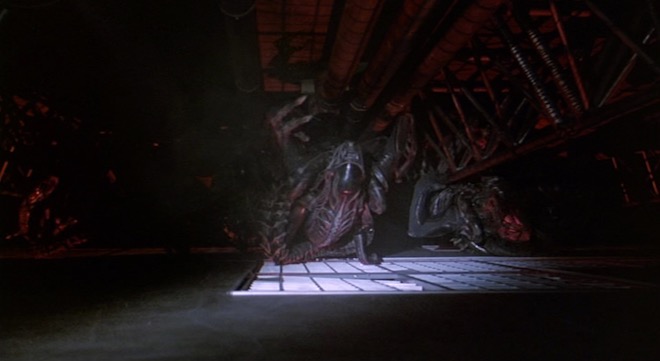In 1983, up-and-coming director James Cameron was hired to script a sequel to Ridley Scott’s 1979 hit Alien. He had to pause halfway through to shoot The Terminator, but the subsequent success of that movie, along with the eventually completed Aliens screenplay, so impressed the powers that be at Fox that they greenlit the film with the relatively inexperienced 31-year-old at the helm.
Although the sequel was awarded a budget of $18.5 million – $7.5 million more than Scott’s original – that was still tight given the much more expansive and ambitious nature of Cameron’s script. Consequently, the director and his team had to come up with some clever tricks to put their vision on celluloid.
1. Mirror Image
When contact is lost with the Hadley’s Hope colony on LV-426, Ripley (Sigourney Weaver) is hired as a sort of alien-consultant to a team of crack marines. The hypersleep capsules from which the team emerge on reaching the planet were expensive to build. Production designer Peter Lamont’s solution was to make just half of them, and place a mirror at the end of the set to double them up.
2. Small Screens
Wide shots of Hadley’s Hope were accomplished with fifth-scale miniatures by Robert and Dennis Skotak of 4-Ward Productions. Although impressive, sprawling across two Pinewood stages, the models didn’t always convince. To help, the crew often downgraded the images by showing them on TV monitors, complete with analogue glitching, or by shooting through practical smoke and rain.
3. Big Screens
The filmmakers opted for rear projection to show views out of cockpit windscreens and colony windows. This worked out cheaper than blue-screen composites, and allowed for dirt and condensation on the glass, which would have been impossible to key optically. Rear projection was also employed for the crash of the dropship – the marines’ getaway vehicle – permitting camera dynamics that again were not possible with compositing technology of the time.
4. Back to Front
A highlight of Aliens is the terrifying scene in which Ripley and her young charge Newt (Carrie Henn) are trapped in a room with two facehuggers, deliberately set loose by sinister Company man Carter Burke (Paul Reiser). These nightmarish spider-hands were primarily puppets trailing cables to their operators. To portray them leaping onto a chair and then towards camera, a floppy facehugger was placed in its final position and then tugged to the floor with a fishing wire. The film was reversed to create the illusion of a jump.
5. Upside Down
Like Scott before him, Cameron was careful to obfuscate the man-in-a-suit nature of the alien drones wherever possible. One technique he used was to film the creatures crawling on the floor, with the camera upside-down so that they appeared to be hanging from the ceiling. This is seen when Michael Biehn’s Hicks peeks through the false ceiling to find out how the motion-tracked aliens can be “inside the room”.
6. Flash Frames
All hell (represented by stark red emergency lighting) breaks loose when the aliens drop through the false ceiling. To punch up the visual impact of the movie’s futuristic weapons, strobelights were aimed at the trigger-happy marines. Taking this effect even further, editor Ray Lovejoy spliced individual frames of white leader film into the shots. As a result, the negative cutter remarked that Aliens‘ 12th reel had more cuts than any complete movie he’d ever worked on.
7. Cotton Cloud
With most of the marines slaughtered, Ripley heads to the atmospheric processing plant to rescue Newt from the alien nest. Aided by the android Bishop (Lance Henriksen) they escape just before the plant’s nuclear reactor explodes. The ensuing mushroom cloud is a miniature sculpture made of cotton wool and fibreglass, illuminated by an internal lightbulb!
8. Hole in the floor
Returning to the orbiting Sulaco, Ripley and friends are ambushed by the stowaway queen, who rips Bishop in half. A pre-split, spring-loaded dummy of Henriksen was constructed for that moment, and was followed by the simple trick of concealing the actor’s legs beneath a hole in the floor. As in the first movie, android blood was represented by milk. This gradually soured as the filming progressed, much to Henriksen’s chagrin as the script required him to be coated in the stuff and even to spit it out of his mouth.
9. Big Battle
The alien queen was constructed and operated by Stan Winston Studios as a full-scale puppet. Two puppeteers were concealed inside, while others moved the legs with rods or controlled the crane from which the body hung. The iconic power loader was similar, with a body builder concealed inside and a counter-weighted support rig. This being before the advent of digital wire removal, all the cables and rods had to be obfuscated with smoke and shifting shadows, though they can still be seen on frame grabs like this one. (The queen is one of my Ten Greatest Movie Puppets of All Time.)
10. Little Battle
For wide shots of the final fight, both the queen and the power loader were duplicated as quarter scale puppets. Controlled from beneath the miniature set via rods and cables, the puppets could perform big movements, like falling into the airlock, which would have been very difficult with the full-size props. (When the airlock door opens, the starfield beyond is a black sheet with Christmas lights on it!) The two scales cut seamlessly together and produce a thrilling finale to this classic film.
For more on the visual effects of James Cameron movies, see my rundown of the top five low-tech effects in Hollywood films (featuring Titanic) and a breakdown of the submarine chase in The Abyss.





